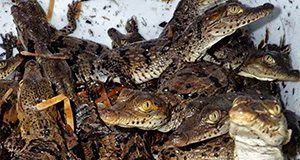
The American crocodile (Crocodylus acutus) is a top predator that lives along the southern tip of peninsular Florida, inhabiting saltwater, brackish water, or freshwater near coastal areas in mangrove-lined ponds, creeks, coves, man-made ponds, and canals. This 3-page fact sheet written by Rebecca G. Harvey, Michiko Squires, Jeff Beauchamp, Frank J. Mazzotti, and Laura A. Brandt and published by the Department of Wildlife Ecology and Conservation explains how monitoring populations of threatened crocodiles can help scientists chart the success of projects to restore the Everglades.
edis.ifas.ufl.edu/UW422
Tag: Jeff Beauchamp
Alligator Abundance and Hydrology (2003–2013): What Long-term Monitoring Can Tell Us about Everglades Restoration
 The American alligator is a powerful indicator for Everglades restoration. It responds clearly to environmental change and is easy and inexpensive to monitor. As top predators and ecological “engineers,” alligators affect nearly all aquatic life in the ecosystem. Thus, trends in alligator populations can tell us whether restoration projects are successful. Alligators may be monitored for both short-term responses (body condition) and longer-term responses to ecosystem change (abundance). This 3-page fact sheet discusses trends in alligator abundance. It was written by Rebecca G. Harvey, Jeff Beauchamp, Robin Bijlani, Frank J. Mazzotti, and Laura A. Brandt, and published by the UF Department of Wildlife Ecology and Conservation, July 2014.
The American alligator is a powerful indicator for Everglades restoration. It responds clearly to environmental change and is easy and inexpensive to monitor. As top predators and ecological “engineers,” alligators affect nearly all aquatic life in the ecosystem. Thus, trends in alligator populations can tell us whether restoration projects are successful. Alligators may be monitored for both short-term responses (body condition) and longer-term responses to ecosystem change (abundance). This 3-page fact sheet discusses trends in alligator abundance. It was written by Rebecca G. Harvey, Jeff Beauchamp, Robin Bijlani, Frank J. Mazzotti, and Laura A. Brandt, and published by the UF Department of Wildlife Ecology and Conservation, July 2014.
http://edis.ifas.ufl.edu/uw387